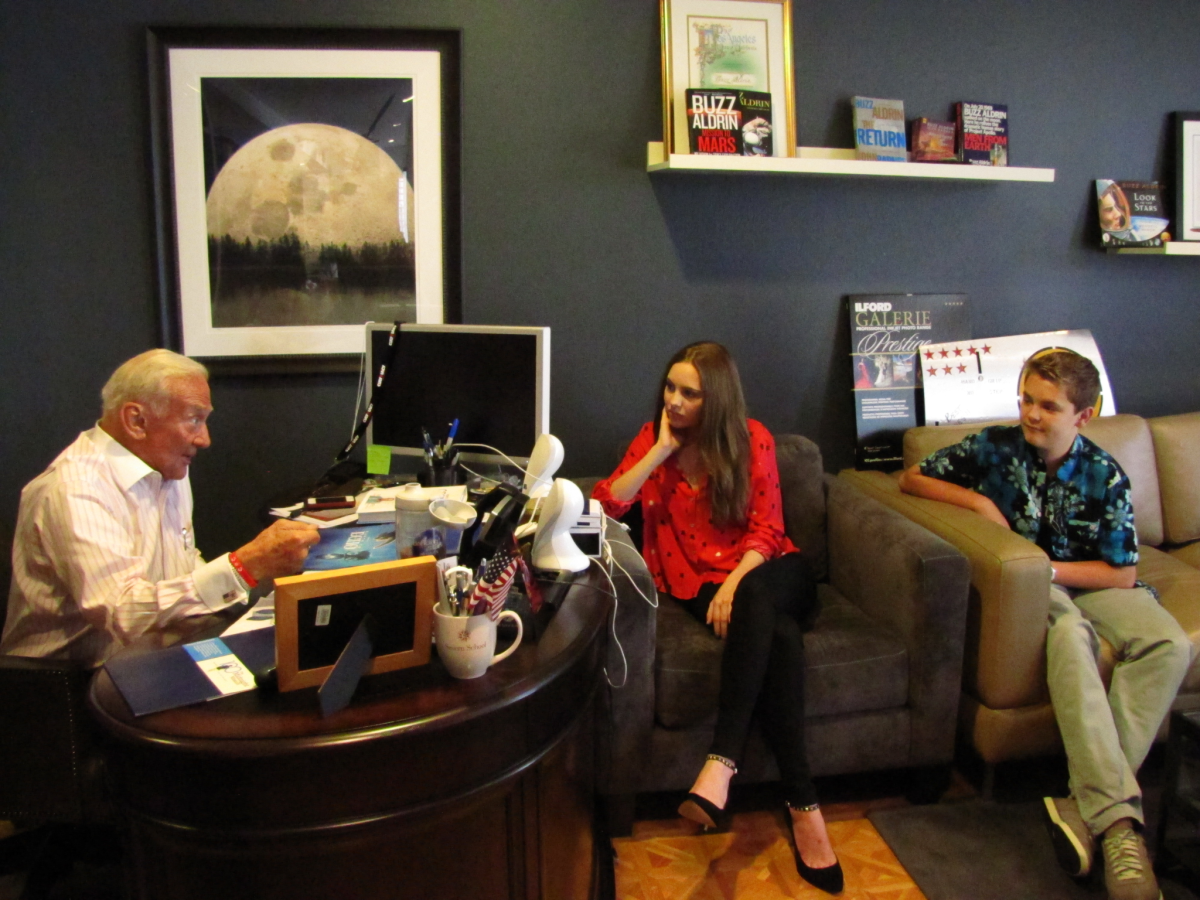Buzz Aldrin makes the case for a one-way manned mission to Mars

- Share via
Buzz Aldrin, the moonwalking astronaut, keeps an office on the 10th floor of a stately condominium building in Westwood. Now 84, he considers himself a “global statesman for space” and expends his considerable vitality advocating for manned exploration of the cosmos from the helm of Buzz Aldrin Enterprises.
Here, on a recent weekday morning, Aldrin entertained a small entourage of Hollywood actors, screenwriters and publicists over an unopened box of Krispy Kreme donuts. The occasion was a meet-and-greet with the young stars of “Earth to Echo,” a new movie about a lonely alien stuck on Earth and the teenagers who try to send it home. (Think “E.T.” for the post-VCR set.)
Amid the clutter of memorabilia in Aldrin’s office, the actors in question — 15-year-olds Reese Hartwig and Ella Wahlestedt — sat next to an imposing desk as if appearing on a late-night talk show. But it was Aldrin, looking smart in a crisp pink-striped dress shirt with his silver hair swept back, who did most of the talking.
The idea was for the kids to interview Aldrin about his trip to the moon 45 years ago this month. Reese, in particular, came prepared, having written a report on Aldrin back in the fourth grade. (Neil Armstrong, Aldrin’s Apollo 11 crewmate, had already been taken.)
But Aldrin needed no prodding to discuss the voyage that put him in the history books. He embarked on a 90-minute discourse that showcased his incisive intellect, his rambling imagination, and his almost pathological attention to detail.
The kids didn’t seem to mind. In fact, they brushed off repeated attempts by Aldrin’s publicist (whose business cards identify her as Aldrin’s Mission Control director) to stanch his monologue. But they did manage to sneak in one question.
“What does the actual moon feel like on your feet?” Reese asked, seizing his chance and leaning forward on the edge of his chair.
“Squishy,” said Aldrin. “The dust is like talcum powder.”
Then the man who earned a doctorate in astronautics from MIT explained exactly how the dust forms from the impact of micrometeorites and the fracturing of ejected rock. He recalled marveling at how the lunar powder sunk beneath his feet, leaving behind a perfect imprint of his moon boot.
Aldrin’s eyes, still wide and blue, glittered as he recounted the two and a half hours he and Armstrong spent on the lunar surface. It’s a story he’s probably told a thousand times. Yet the details seemed sharp and vivid, perhaps codified more by their telling than their memory.
He described, weightless step by weightless step, how Armstrong disembarked from the lunar module and immediately scooped up a pocketful of dust — a contingency sample in case they had to make a quick exit. He explained how it felt to follow his companion onto the “magnificent desolation” of the lunar plain, being careful not to let the door close behind him as he exited the Eagle. (“There was no handle on the outside!” he said.)
He bragged about relieving himself while standing on the moon, then retraced the precise choreography of their famous explorations. Armstrong captured their visit on film, snapping the photo of Aldrin that was later further immortalized by MTV. (An honorary Moonman statuette from the channel’s Video Music Awards stands on a pedestal in Aldrin’s office.)
Aldrin’s infamous displeasure at being second to walk on the moon seems to have faded with time. “The commander always makes the first symbolic exit,” he said.
Instead, his rancor has shifted to feeling slighted by NASA’s decision to name an underwater space training facility after the late astronaut Manley “Sonny” Carter Jr., despite the fact that Aldrin pioneered the technique.
But the offense hasn’t stopped Aldrin from promoting NASA and human space exploration using unexpected and creative means. He has teamed up with Snoop Dogg to rap about his “Rocket Experience” and made cameo appearances on “The Simpsons” and “30 Rock.” He even graced the ballroom floor of “Dancing with the Stars” but did not advance past the second round.
He has also sought to pique public interest in space through science fiction, a genre in which he has dabbled for almost two decades.
Among them is the 1996 novel “Encounter with Tiber,” which Aldrin co-wrote with John Barnes. Aldrin admits he stole parts of his plot from Carl Sagan’s 1985 bestseller “Contact.” But like all good sci-fi, it contains enough elements of reality to blur the line between fact and fiction.
For instance, “Encounter with Tiber” begins with scientists listening to the void of space from an antenna placed on the far side of the moon, to avoid radio interference from Earth. NASA has long considered such a project, and scientists at last year’s annual meeting of the American Geophysical Union reported progress on how such an antenna could be assembled using robots controlled by orbiting astronauts.
From there, Aldrin’s imagination takes over. The signals decoded by the antenna tell the story of an alien civilization in search of new planets to colonize, including one called Earth.
Here, certain parallels between Aldrin’s book and his four-point plan for the future of space exploration begin to emerge: Aldrin vehemently favors establishing a human colony on Mars. (Sending Americans back to the moon would be a waste of time, he said.) And Aldrin is not alone — more than 200,000 people have applied to relocate to the Red Planet through Mars One, a Dutch start-up that hopes to establish a settlement there by 2023.
Aldrin and Mars One both envision the first passengers taking a one-way trip.
“Why are we so sympathetically attached to six people who want to be pioneers and who want to leave their family behind?” Aldrin challenged the young movie stars. “Do you think Russia would do any different?”
If future astronauts sent to Mars come home to Earth, Aldrin said, “they’re going to write a book, they’re going to write their memoirs, they’re going to give speeches all over the country.” The tone of his voice made his disapproval clear, despite the similar trajectory of his own life after space.
He settled back in his chair, his face falling in line with a low-hanging picture on the wall next to his desk. It depicts an absurdly large moon rising over the shore of a forested lake.
“The hardest people to ever bring back are the first people to land.”
Follow me on Twitter @ScienceJulia for all things science.







